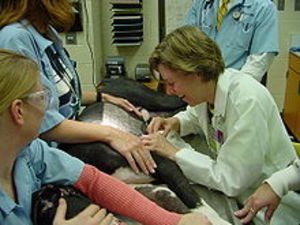Blood pressure is not usually taken in a normal dog veterinary check up and only taken if the vet suspects something is wrong, such as kidney problems or heart disease. Taking a dog’s blood pressure is not as easy as it is as taking the dog owner’s blood pressure, but the theory is similar. According to PetPlace.com the normal blood pressure range of a healthy dog is from 110/55 to 160/100.
The Upper Number
The upper number used is called the systolic value and the bottom lower is called the diastolic value. If these names sound familiar, it’s because they are the same values used in taking human blood pressure.
Dog owners and vets often check the systolic value of a dog, because it’s the same as the pulse. According to Dog Owner’s Home Veterinary Handbook – Fourth Edition (Howell Book House; 2007), a normal adult dog’s pulse ranges from 60 to 160 beats per minute. Toy sized dogs tend to have a higher pulse rate than larger dogs. Healthy newborn puppies have a pulse of 160 to 200 breaths per minute. It is normal for puppy pulse rates to go up to 220 breaths per minute until the pup reaches the ripe old age of three weeks.
The Lower Number
The lower number, or diastolic pressure, is a bit more difficult to describe. In humans, it’s the number reached after the doctor finally lets go of the blood pressure cuff’s grip on your arm. WebMD defines it as the minimum normal beats per minute of a pulse, with systolic pressure being the normal maximum range. While systolic pressure measures the pressure of the blood banging against the vessel walls, diastolic pressure is that measurement between bangs.
This is a bit trickier to measure on a dog. This is painless, but dogs tend to not like their limbs handled. Some dogs will prefer their vets to check their genitalia rather than their legs or paws. If you know your dog is like this, please tell your vet so a muzzle can be placed on the dog. Using sedatives will automatically lower the dog’s blood pressure, which guarantees an inaccurate reading.
A vet will have to shave a small patch in the fur on the leg near an artery in order to get an accurate reading. The vet also may have to take several readings to try and get an accurate one, especially if the dog does not want to stay still.
Problems
Dogs can get high blood pressure or hypertension. This is when the upper number is 170 or more and the lower number is 110 or more. This is the only symptom of high blood pressure. But if left untreated, this can be fatal for the dog.
Dogs also suffer from low blood pressure or hypotension. This is when numbers are below normal, which can happen during shock or a sudden traumatic injury, such as getting hit by a car.
Resources:
Dog Owner’s Home Veterinary Handbook – Fourth Edition. Debra M Eldredge, DVM, et al. Howell Book House; 2007.
The Veterinarian’s Guide to Your Dog’s Symptoms. Michael S. Garvey, DVM, et al. Villard; 1999.
Pet Place.com. “Blood Pressure in Dogs.
WebMD. Know Your Blood Pressure Numbers.” http://www.webmd.com/hypertension-high-blood-pressure/guide/diastolic-and-systolic-blood-pressure-know-your-numbers



